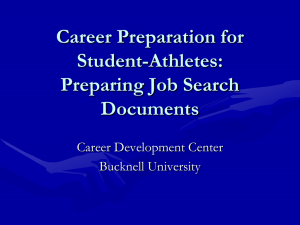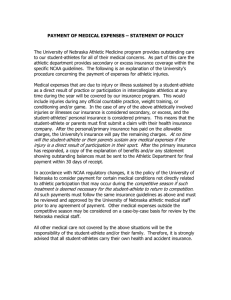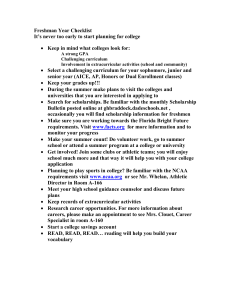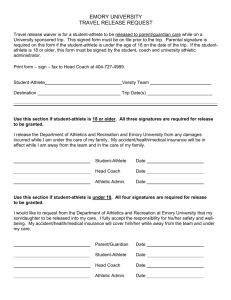Assessment of Georgia Tech visit
advertisement
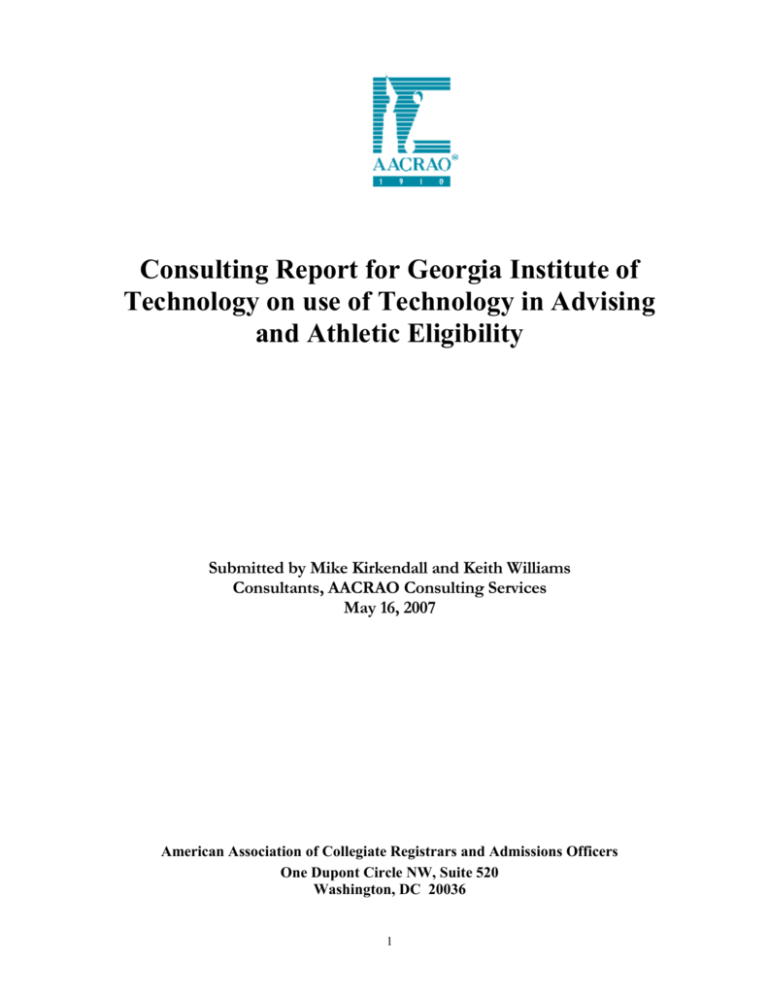
Consulting Report for Georgia Institute of Technology on use of Technology in Advising and Athletic Eligibility Submitted by Mike Kirkendall and Keith Williams Consultants, AACRAO Consulting Services May 16, 2007 American Association of Collegiate Registrars and Admissions Officers One Dupont Circle NW, Suite 520 Washington, DC 20036 1 Student Advising and Student-Athlete Advising We were informed that there has been a move away from using faculty for student advising because of an ever-increasing emphasis on faculty research. However, the small number of professional advisors results in a high student to advisor ratio. For example, the College of Management (COM) has three (including one search in progress) full-time advisors but enrolls 1200 undergraduate students. The largest concentration of student-athletes by far is in the College of Management, and that college works closely with Athletic Advising to check student progress. This last year, advisors from COM went to the Athletic Advising offices to meet with studentathletes. Unfortunately, the pressure on COM advising staff meant that these appointments were only 15 minutes long. The Director of Advising said that her staff could not do any developmental advising in this short period of time, and could barely cover degree requirements. The well-trained advisors are clearly frustrated that they spend all their time checking degree requirements rather than being able to have more meaningful conversations about student issues and goals. This lack of quality advising time is significant for all students but is particularly so for student-athletes who have rigorous practice and competition schedules (we were told this averages 30 hours a week) that further reduce their study and planning time. Though Athletic Advising has many young and recently-hired staff, our meeting with them emphasized their eagerness to provide excellent student service. Athletic Advising currently has eight advisors and is searching for one more. This staff serves approximately 425 student-athletes. When the athletic advisors were asked for the one thing they needed to do a better job helping students, they all responded that a computerized degree audit is at the top of their list. Their frustration with the flawed CAPP system was very apparent; they are anxious to work on a project that would give students immediate and on-going feedback about their degree progress and eligibility. The current process requires that student-athletes meet with their Athletic Advisor to choose courses. Unfortunately, there is nothing to guarantee that students will then register for the correct courses once they are in the registration system. At present, students are potentially able to change their schedules in a way that would lead to loss in NCAA eligibility. A degree audit system would allow students and advisors to immediately check the impact of changes in the students’ schedules. Finally, a separate theme came out of our meeting with Athletic Advising that is worth mentioning: course availability. Despite the fact that all student-athletes have priority registration (priority registration provides registration access before other students have access to the system), the athletic advisors commented that during registration certain courses were unavailable to their students. In particular, courses are restricted as being available to students in a specific major and are unavailable as electives. The professional advisors we met with in the schools did not think this was a problem, saying that such restrictions are common on all campuses and have remained fairly constant at Georgia Tech. They disputed the sense of the athletic advisors that this was a new phenomenon. They added that special sections of the freshmen seminar course have been added specifically for student-athletes and that some required course sections are scheduled to coordinate with practice schedules. In addition, there is no control on the number or timing of internal transfers from one college to another. Students are given one ‘free’ transfer: they can choose to change colleges at any point in the semester, including after the schedule of courses hsas been built for the upcoming term, once in their careers without any review or approval of the college. This, along with the growth in the size of the student body over the last several years, makes it very difficult for the colleges to accurately predict course demand and to build schedules 2 that will satisfy student preferences or needs. This is a problem on many campuses but is critical when a group of students, such as athletes, need to maintain progress on their degrees to remain eligible to participate in athletics. Recommendations Georgia Tech seems to still be in the transition between a faculty advising and a professional advising model. At present there are not enough professional advisors in the academic units to provide anything but the most rudimentary check of degree requirements. By comparison, student-athletes have access to rich and plentiful advising and academic support resources. A review of advising resources, with goals for decreasing the student to advisor ratio, should be done. The implementation of a comprehensive and accurate degree audit product would provide a common source of degree progress information for students, professional advisors, and athletics advisors. Since these implementations generally are completed on a rolling basis, with individual colleges being done in a set order, I would recommend that the coding and activation of the audit begin in the College of Management. (See following sections for further recommendations on degree audit software selection and implementation.) Included in the degree audit implementation should be the ability for students to process ‘what if’ audits. Students could check their records against not just their current majors but also against other majors they may be interested in possibly pursuing. Robust course capacity planning is a cornerstone of providing sections to students when needed, helping to ensure satisfactory academic progress. The current policy on the timing of internal transfers should be changed so that the academic units can more accurately plan for capacity needs. Allowing students to change transfer internally after course section planning puts students and advisors in the frustrating position of not being able to get the courses needed for degree progress. Degree Audit Software Selection and Implementation The degree audit software ‘CAPP’ was chosen at the state level for all state schools without an evaluation of campus needs. A robust software product search would have analyzed the needs of each campus, created a Request for Proposals (RFP), and solicited vendors to respond to the RFP with information about their product’s ability to perform the tasks required. To further doom the product, no resources were allocated to implement the software. Without project management or the staff needed to write and edit degree requirements the software is not able to accurately check students degree requirements. When students ran their audits, the errors they received made them believe they had unfulfilled requirements, causing them undue stress and sending them to the advising office where it was explained that they were fine and it was just a software glitch. The Electrical Engineering School has announced that they will not use the product. The Registrar was under the impression that the School of Management used the software the most but when we met with the Director of Advising, she told us that they discourage students from using it because of the errors. 3 Since there weren’t staff resources added to maintain the audit, inadequate coding could not be corrected. The audit is only used as a starting point for checking degree requirements for studentathletes but is so flawed that the hard copies we saw were covered with hand-written corrections. Recommendations A degree audit system is a valuable tool for any campus but given Georgia Tech’s very small professional advising staff and high need to track student-athlete progress, it is critical. An audit capable of accurately checking a student’s progress toward the degree would free up time for the type of developmental advising that is so critical for student success and retention. This is particularly true for student-athletes who have large amounts of time dedicated to participating in their sports and are, hence, at greater risk. We have learned from Sungard/CAPP consultants that CAPP does not have the capability of checking some of the specific requirements for the degree progress of Tech student (in particular it cannot enforce limitations on low grades that can be applied to the major, and it lacks the ability to perform a percentage check over past semesters needed in the athletic eligibility check.) This leaves two major vendors that should be considered for a new implementation of degree audit software, DARS and DegreeWorks. DARS is by far the older of the two systems having been written at Miami University in the early 80’s. DARS has developed a module for checking athletic eligibility and progress that is used at many schools with large athletic programs (e.g. Ohio State, USC, Wisconsin at Madison). DegreeWorks does not currently have a module for checking eligibility but they have expressed a desire to develop one and are confident that they will be able to in the near future. DegreeWorks has recently been purchased by Sungard, the company that owns and maintains the Banner Student Information System, owned and used in the Georgia State system. An RFP should be written, overseen by the Registrar’s Office, and should include input on degree requirements needs for the coding of the software from each of the colleges at the University. The RFP should include the need to review eligibility requirements for student-athletes. (Requirements can appear for student subpopulations based on the data base coding.) Once the proposals are received from vendors, a review committee composed of representatives from the registrar’s office, professional advisors from each college, the Athletics Advising Office, and the administrative computing group should meet to review the proposals and select a vendor. Once a system is chosen, this same group should guide the implementation, including drafting a project communication plan for the campus and creating an implementation timeline. 4 Athletic Academic Eligibility at Georgia Tech The momentum from the 2005 NCAA infractions report has created an improved athletic academic certification process at Georgia Tech, by establishing checks and balances and institutional controls, but it is one that is a labor intensive, paper driven process and still vulnerable to errors that could lead to additional infractions. When the NCAA began increasing the student-athlete academic benchmarks in the 1990s many institutions established similar paper driven models to quickly insert academic personnel as a check and balance into the certification process. High workloads, personnel turnover and advances in technology prompted many of these institutions to utilize programming, web services and vendor built academic applications as tools in the collection, review and validation of student-athlete academic information needed for eligibility reporting. A majority of the human resources at Georgia Tech that have been directed to manage, perform and monitor the athletic academic eligibility process are new to the campus and this certification model. Given the extent of the workload, the complexity of balancing NCAA benchmarks with Georgia Tech academic rules and the high profile of the Georgia Tech athletics programs, it is only the staff’s dedication, energy, and attention to detail that has ensured the success of this process. Over time, even these motivated employees may be worn down, and eventual mistakes made. Additionally, the institution is vulnerable if certain personnel in the certification process leave Georgia Tech. Knowledgeable and experienced personnel have been hired into key Registrar, Compliance and Athletic Association positions. Though their positions could be filled over time, the loss of any of these persons would severely compromise the effectiveness of this process until new personnel could be brought up to speed, endangering the accuracy of the compliance process. Fortunately, in preparation for a recent internal audit, documentation of the process was created that could lessen the impact of personnel turnover. Recommended Technology Enhancements Georgia Tech is not effectively utilizing available technologies to enhance and validate the athletic academic eligibility process. In fact, the little technology that is being used is actually adding to the workload by producing unreliable data. The CAPP audit produced to determine a studentathlete’s ”degree applicability of courses” (vital in eligibility determination) proved unreliable to the Assistant Registrar who determines eligibility; she then added a step to run it by a colleague for review. Technology can, and should, be a component of the athletic certification process. It can relieve the pressures of manual paper processes and serve as an additional institutional control when monitoring eligibility data. The use of technology will never be a “magic bullet” that identifies, certifies, and reports student-athletes in a seamless, automated process void of human review. An institution should be prepared to assign human resources to manage the process, certifying the student-athletes academic performance against the NCAA benchmarks, and coordinating all the athletic academic eligibility reporting requirements. 5 A couple of technological enhancements can be initiated for increased student-athlete monitoring and reporting 1) Degree Audit System in Eligibility Processing The degree audit system is the filter by which all students’ academic progress is measured. Maintained by offices outside the Athletic Association, the Registrar and the academic units, and the use of this application for student-athletes assessments is crucial in order to evaluate the student-athlete population in the same manner as the non-athlete student population. NCAA bylaw 14.02.5 “Good Academic Standing and Progress Toward Degree” states: The phrases "good academic standing" and "progress toward degree" are to be interpreted at each member institution by the academic officials who determine the meaning and application of such phrases for all students, subject to the controlling regulations of the institution. So if the degree audit is the tool by which all students at an institution are determining their academic progress then that tool has to be used to determine the academic progress of the student-athletes as well. In terms of conflicts of interest, checks and balances, and institutional controls, this arrangement should be preferable to the institution. The Registrar’s Office would maintain the accuracy of the degree coding while the academic advisors record exceptions in the system, allowing the Athletic Association personnel the ability to review the information but not alter or influence the data. A comprehensive degree audit application, with the ability to project performance in anticipated coursework, is not only a benefit for the student-athlete forecasting and certification process but is also a benefit for non-athlete student needs. Tracking progress through a degree program with the ability to forecast course degree applicability or g.p.a., and test out degree plans would make all students better informed about their academic standing. Forecasting student-athlete progress Forecasting is the process for projecting student-athlete academic performance and thus their academic eligibility status. Forecasting allows a student (or advisor) to run “what-if” scenarios for completing planned coursework, project a possible g.p.a. for planned coursework and to compare their academic history against the institutions academic degree plans to determine their best degree footing. In institutions without a detailed degree audit system in place, this process is usually handled by hand by many of the same personnel responsible for eligibility processing, thus adding to the already heavy paper-process workload. Forecasting the academic success (or failure) of a student-athlete is the single most important factor in preventing an infraction from occurring, or preparing the institution when studentathletes fail to clear their benchmarks. The forecasting data for student-athletes would never be reported as final and the certifying agent would always wait until the actual grades and g.p.a. calculations were available before reporting a student-athlete’s actual eligibility status. 6 Forecasting continuing student-athletes progress Being able to forecast the success or failure of student-athletes in the context of course degree applicability, g.p.a. and percentage of degree completed allows certain preventative measures to occur: Allows eligibility personnel to identify those student-athletes who will “clearly meet their benchmarks”, thus reducing the stress associated with reviewing these students Identifies those student-athletes who “clearly will not meet their benchmark” and those “on the bubble” allowing eligibility personnel to watch them more closely and encouraging academic tutors and advisors to meet with these student-athlete sooner Provides information so athletic advisors can more accurately advise student-athletes during early registration periods for courses needed to stay eligible Permits Athletic Compliance personnel to begin NCAA appeal and waiver processes earlier if it appears the student-athlete will not meet their benchmarks Allows more time so Media Relations personnel can prepare earlier to disseminate information about ineligible student-athletes Provides University administrators a “heads-up” regarding student-athlete eligibility status The institution demonstrates that it is proactive regarding eligibility issues Forecasting for prospective transfer students The forecasting of a transfer student-athlete during the recruitment phase allows the institution to determine which transfer student-athletes would or would not be eligible at Georgia Tech, and thus whether to offer them a scholarship though eligible at the time of the transfer, would soon be at risk of ineligibility after beginning Georgia Tech coursework Forecasting of transfer student-athletes should occur through the same machinery and process that is used to forecast continuing student-athletes. Usually this involves the Admissions Office creating a record for the recruit in the student information system and articulating their transfer coursework during the identification and recruitment phase, allowing for an earlier assessment. 2) Athletic certification application An additional technology piece that can be implemented is an application that takes the student information system and degree audit academic information and processes it through the NCAA benchmarks, summarizing the student-athlete’s eligibility standing for the athletic advisors and certifying personnel. Typically, this type of application will display the student-athlete’s standing in regards to the 18/24 hour rules, g.p.a. percentage rules, and calculating a percentage to degree in addition to applying institutional rules that may influence the certification process. These applications do not exist commercially and are typically built in-house as a module of the degree audit system. They are not complex systems and could be as simple as a population and display of the Georgia Tech’s Registrar’s “blue form” behind a secure interface for use by athletic, academic or Registrar personnel to initiate discussions and reviews. An in-house module can also provide electronic storage for non-academic data needed for athletic reporting that typically does not reside anywhere on student information systems or degree audit 7 systems. Elements regarding “qualifier status,” “seasons used,” “reasons for leaving the institution” and waivers that are used to accurately compute a student-athlete’s eligibility or are needed for yearly Academic Progress Rate (APR) reporting could be captured over time and held in this file. CAi The NCAA responded to institutions that needed technology help with their certification processes by developing an online application called Compliance Assistant interactive (CAi). This service can serve as a certification application system by allowing member institutions to upload student-athlete demographic, financial aid and academic information to the site for viewing by all assigned campus constituents. The CAi is a data-holding database that is an optional service provided by the NCAA with some pros and cons to be considered before using: Pros of CAi Fields available for demographic, financial aid and academic eligibility student-athlete data Once XML program is written, mapped and tested, upload capabilities are simple and can be automated Reporting function incorporated; both standard and ad-hoc reports available for download Data in CAi can be downloaded for institutional use in other applications Data held in CAi will be used in yearly APR reporting and can be migrated to the APP application, making for an easier APR process NCAA technical support is available and responsive A network of users at other institutions are willing to assist with technical issues Cons of CAi Security concerns of storing student-athlete data outside of university servers and security (The same data will have to be submitted eventually with the APR reporting) Requires XML programming knowledge and a high level of internal tech support during initial programming, mapping and testing Designed by NCAA for all member institutions; alterations for specific institutional needs is not available Authorization to CAi are maintained, granted and monitored by the institution The data uploaded and displayed is of actual student-athlete academic performance and does not include any forecasting of student-athlete status Does not facilitate the storage of all non-academic APR data Recommendations The Athletic Association should consider creating an IT resource position to be shared with the Registrar’s Office. OIT computing resources are shared by the entire campus and, even when fully staffed, are challenging to get assigned to Registrar initiatives. A dedicated technical resource, whose use would be prioritized by the Registrar’s Office and the Athletic Advising unit, could make headway on many technical initiatives until OIT resources are secured for larger projects. 8 A comprehensive degree audit system should be in place with an institutional commitment to initiate, support, and maintain the system. The system should have some forecasting capabilities, allowing students and advisors to determine the degree applicability of planned courses. The Registrar’s Office should own the system and the project to effectively roll out the product, maintain its accuracy, train its users and champion its usage should all reside within that office. An Assistant Registrar position for Degree Audits should be created and funded to oversee this cornerstone application. Georgia Tech should import data to the NCAA’s CAi application. Clear and detailed policies and procedures should be developed regarding upload timing, personnel access and data changes. The Athletic Association Compliance Office should be the campus contact for the institution and be charged with granting and monitoring access to the system. The Registrar’s Office should coordinate the upload of all data to CAi and address any data integrity issues. The Athletic Advising unit should continue to submit the APR data but should utilize the migration of data from the CAi system to take advantage of the smaller APR flat file upload. Georgia Tech should develop an in-house athletic certification application to assist in the monitoring and institutional controls associated with their student-athletes. Online versions of the eligibility forms, pre-populated with academic and degree audit information, with Georgia Tech academic rules included could be an effective and necessary first step. 9

